Magical Ubud is the most popular destination in Bali, boasting rich jungles, ancient temples, and an ethereal beauty that only magnifies its spiritual mystique. While it’s easy to pack your itinerary with all there is to do, a crammed scheduled feels contradictory to Ubud’s ethos. Here, we expand on our 3-day itinerary, with a more languid 4 days in Ubud.
This guide still has all the main sights and photo spots as our 3-day guide, but at a slower pace and with a few more add-ons, to provide a more comprehensive look at Ubud and the surrounding region.
Jump to:
- Getting to Ubud
- Getting Around Ubud
- How Many Days in Ubud?
- 4 Days in Ubud
Getting to Ubud
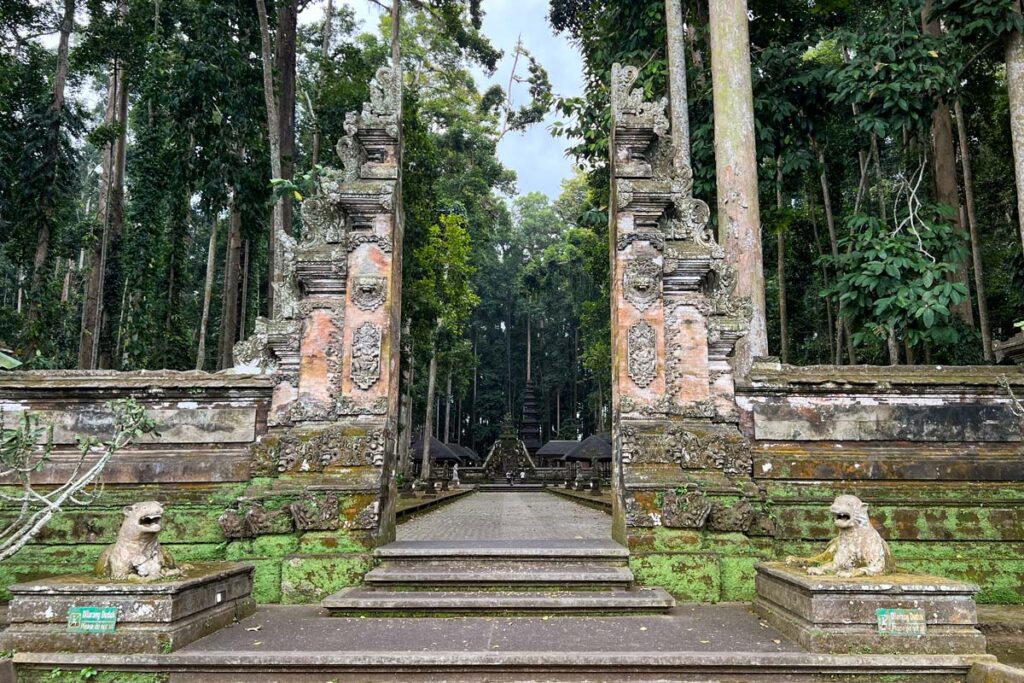
Flights
Bali has one commercial airport, Ngurah Rai International, located just south of Denpasar. From here, it’s about a 1-hour drive to Ubud.
Shuttle Service
Many Ubud hotels offer roundtrip shuttle service, from either the airport or another part of the island. Check with your hotel to see if they provide transportation.
Private Car
Many Balinese work as private drivers, offering affordable rides for anywhere you want to go on the island. The drivers do not have websites, instead operating off SMS and word of mouth.
Every tourist seems to have a “guy”, recommended to them by a friend who has visited Bali previously. For what it’s worth, we used Agus, who was great (phone: +62 813-3764-8755). Another wonderful driver is Reny (+62 819-9785-3082).
Grab (the Uber of Southeast Asia)
Grab is extremely prevalent around Bali, and offers a low-cost and convenient way to get around.
You can download the Grab app in the Apple or Google Play store. Drivers typically arrive within minutes, and rates are insanely cheap. For example, you can get from Ubud to a hotel 20 minutes away for under $1 USD.
Getting Around Ubud
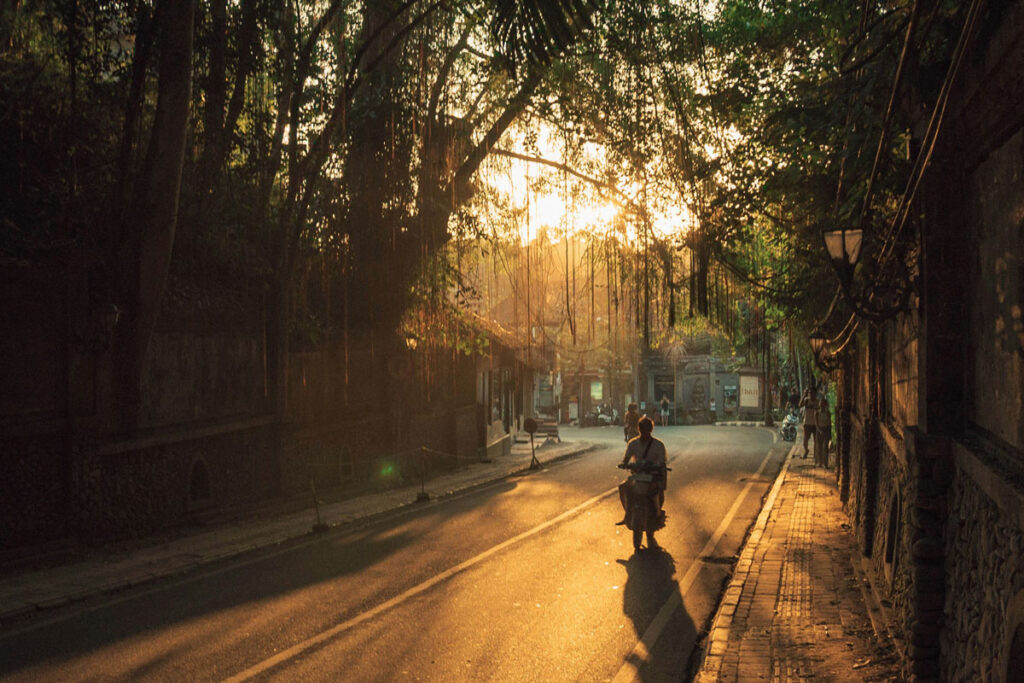
There is no public transportation around Ubud, but the city center is easily traversable by foot.
Additionally, the Grab app has made private transportation incredibly easy. Simply download the Grab app (see above) and call a ride any time you need one.
How Many Days in Ubud?
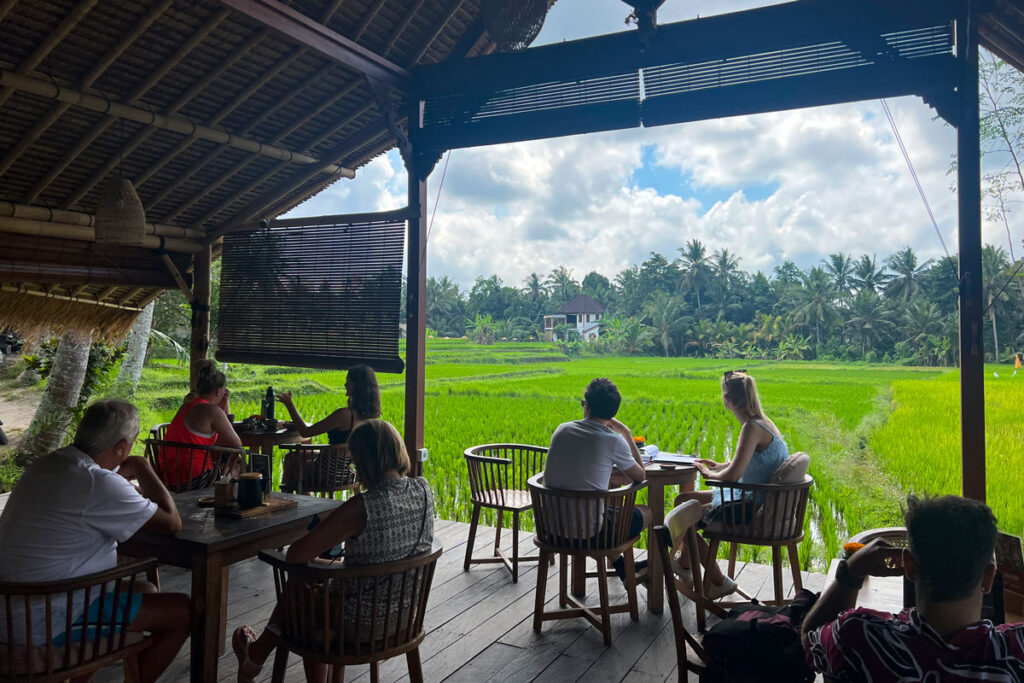
You can spend anywhere from a few days to a week in Ubud. We always recommend at least 3 full days minimum, to see the city center and some surrounding highlights.
However, three days will likely feel jam-packed, with all there is to do. For a more relaxing time, we recommend 4 days in Ubud or more, including at least one day with nothing on the itinerary.
Allowing yourself a day to lounge poolside, perhaps coupled with either a massage or yoga class, feels essential to the spirit of Ubud.
4 Days in Ubud
Day #1: Ubud City Center
Get acquainted with the heart of Ubud on your first day in town. After you see the landmarks below, you’ll still have plenty of time to do some shopping or unwind at one of Ubud’s hip restaurants and cocktail bars.
Ubud Palace

Begin at the 19th century Ubud Palace, which sits on the city center’s primary intersection and town plaza. This is the historic residence of the royal family, and while not ancient, it’s still a fantastic example of traditional Balinese architecture.
The grounds are not large, and can easily be explored in 30 minutes. There are also frequent shows of traditional Balinese dance – if you’re lucky, you may catch a performance while you’re there.
Pura Taman Saraswati Temple

One block down from Ubud Palace is Saraswati Temple, also known as the Ubud Water Palace. Dedicated to the Hindu goddess of the same name, this iconic structure is particularly famous for the expansive lotus pond that decorates the front entry.
Guests must wear the traditional garb provided at the ticket counter, and cannot visit the inner sanctum of the complex. But it’s still a stunning temple to visit, with exquisite architecture.
Goa Gajah (Elephant Cave)
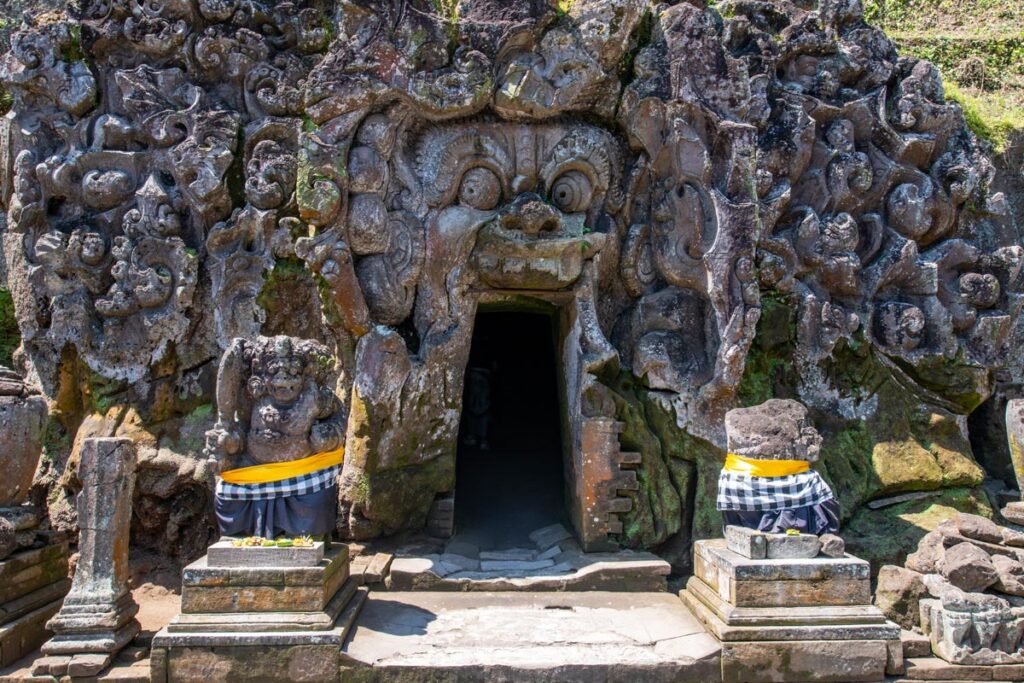
This fascinating complex is one of the most ancient structures in Ubud. Originally a temple from the 9th century, it was only rediscovered by archeologists in the 1920s.
The entire complex can easily take an hour to explore in-depth, but the crown jewel is the namesake cave.
The entry to Elephant Cave is intricately carved into a face, presumed to be either an elephant or the Hindu god Ganesh. Inside, the narrow passageway leads to an inner sanctum that pilgrims have traveled to visit for over a thousand years.
Shopping in Ubud
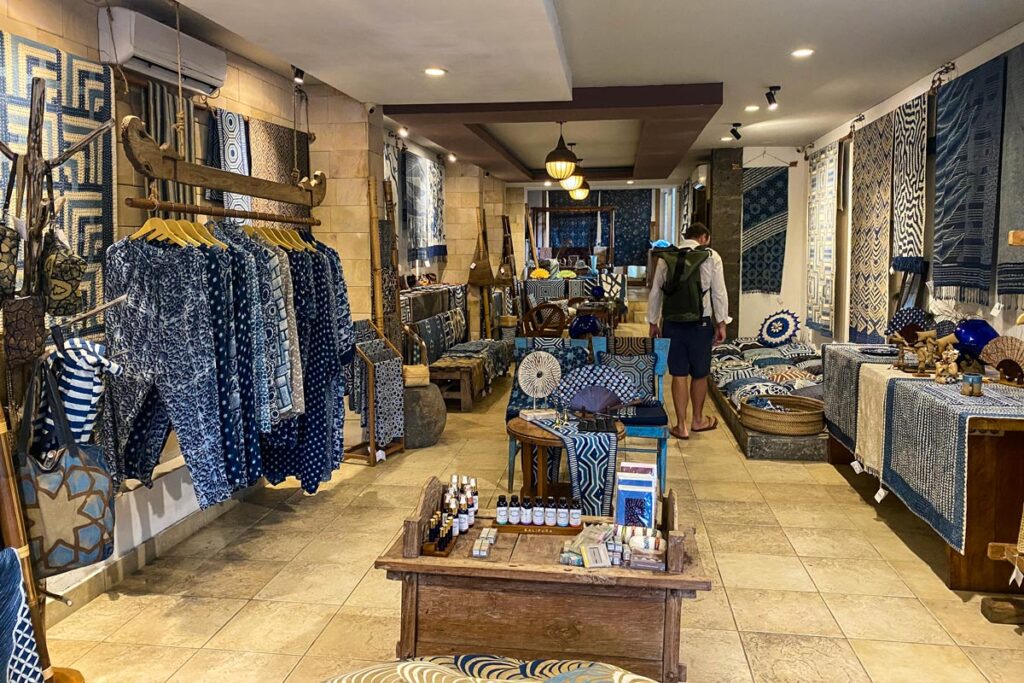
If you’re looking to bring home a unique souvenir from your time in Bali, then today is a good day to explore Ubud’s many stores and boutiques.
More serious shoppers can easily spend a couple of hours winding up and down the main streets, where the healthy tourist economy keeps copious amounts of stores in business.
However, if you’re looking for something in particular, we’ve included a few of our favorites (hyperlinked with directions) below:
Jewelry
Asterisk* is a fun boutique selling dainty gold and silver pieces. Yin Jewelry for the Soul offers necklaces, bracelets, and earrings that often play up the spiritual side of Bali, with om symbols and lotus flowers.
Home Goods and Textiles
Itak Batik is one of our favorite stores in Ubud, with quality artisan goods and traditional textiles. Threads of Life is another great option for fair trade textiles. Ubud Ceramics carries a variety of vases, trays, kitchen and bathware, traditional tea kettles, and more.
Additionally, if you’re in the market for traditional Balinese carvings or furniture, head to Jl. Raya Andong, the main road between Ubud and Tegallalang. Here, you’ll find local artisans selling their wares, many of which are extremely ornate, at wholesale prices.
If you want to check out Jl. Raya Andong, go on the day you’re visiting Tegallalang anyway (we’ve included it on day #2 below). None of the artisans have a web presence, so you’ll need to cruise the street and pull over whenever you see something you like.
Bath and Body
The higher-end Kou specializes in natural soaps. Lemongrass offers a host of locally-sourced body washes, bath salts, lotions, massage oils, and more.
Utama Spice (a popular brand throughout Bali) has an Ubud storefront with a large selection of all-natural skincare, haircare, aromatherapy oils, and home products.
Foodstuffs
Ubud Raw Chocolate and Cacao sells high-quality, artisan chocolates, cacao powder, and other desserts that make a great gift for friends back home.
Artteas, which also doubles as a tea house, retails top-grade teas and tea-ware.
Public Market
Ubud Art Market is undeniably the largest market in town. The maze of narrow alleyways is crammed with vendors hawking everything from art, purses, and textiles, to home decor and knick-knacks.
What may seem “cheap” to some is “good value” to others, but regardless, it’s fun to peruse, and you may come away with a well-haggled treasure.
Day #2: Temples and Terraces
Day #2 will get you just outside of Ubud city limits. Both Tirta Empul and Tegallalang Rice Terrace are arguably the two most popular sites (and photo ops) in the region.
Tirta Empul Temple

If you’re going to visit one temple in Bali, then make it Tirta Empul.
First built in 962 A.D. to honor the Hindu god Vishnu, this ancient water temple is considered one of the holiest places on the island. The waters stem from local mountain springs, flowing down the mountain hillsides before feeding into two pools that have purified pilgrims for over a thousand years.
Visitors will receive proper attire to enter the pools with their entry ticket. Please just remember that this is an active house of worship, and be respectful during your time here.
While the ritual purification pools are the main attraction, the entire complex is worth exploring. Plan to spend an hour or more here – it’s best in early morning, before the crowds and midday heat arrive.
Directions. Tirta Empul is located approximately a 20-minute drive outside of Ubud.
Gunung Kawi Temple
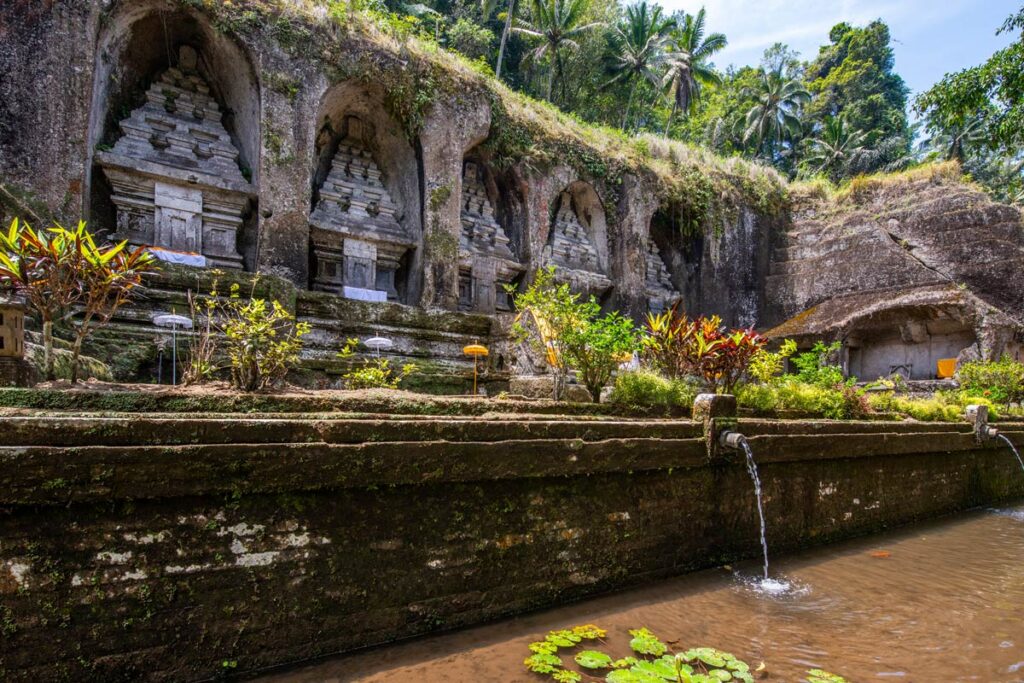
Located 5 minutes down the road from Tirta Empul, Gunung Kawi is another temple marvel. Known as the Valley of the Balinese Kings, it includes 10 shrines carved into a cliff in the 11th century, as well as rice terraces and jungle terrain.
To get here, you’ll park at the top of the hill and then walk approximately 10 minutes down into the ravine where the temple is located. The entire visit should take just under an hour.
Tegallalang Rice Terrace
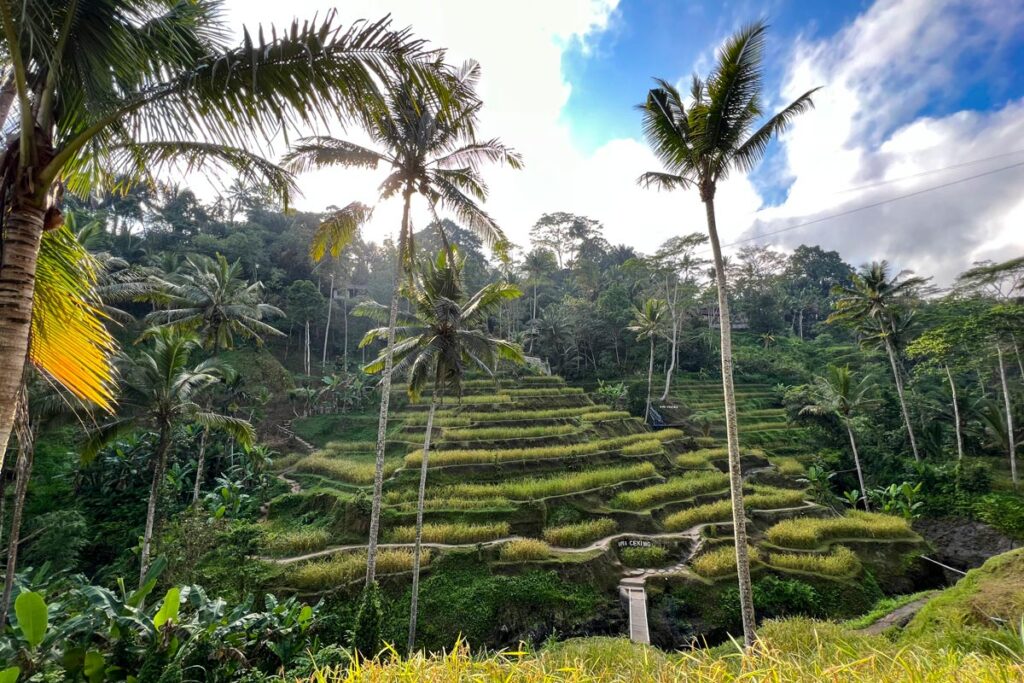
If you ever see lush marketing images of verdant rice terraces carved into hillsides, it’s inevitably Tegallalang. Located about halfway between Ubud and Tirta Empul, today is a good time to visit the iconic photo spot.
Know before you go: What once used to be expansive, meandering trails along the terraces have recently been closed off by enterprising locals, who recognize an income opportunity when they see one.
Now, the many terraces are fenced off from one another, with each requiring a paid ticket for entry. You’ll still be able to walk a decent distance along “your” section, but it’s not the holistic experience it used to be.
Directions: while you can choose from multiple entry points, we personally did Uma Ceking, which is considered one of the primary stretches of Tegallalang.
Day #3: Wellness and Coffee
Physical and spiritual restoration is essential to the ethos of Ubud, and we strongly recommend having a day with nothing on the schedule, in order to fully soak up the essence of this magical place.
Enjoy a leisurely day poolside, or indulge in an awakening yoga class or restorative massage.
Whatever your relaxation of choice, we’ve included a few of our local favorites below.
Yoga
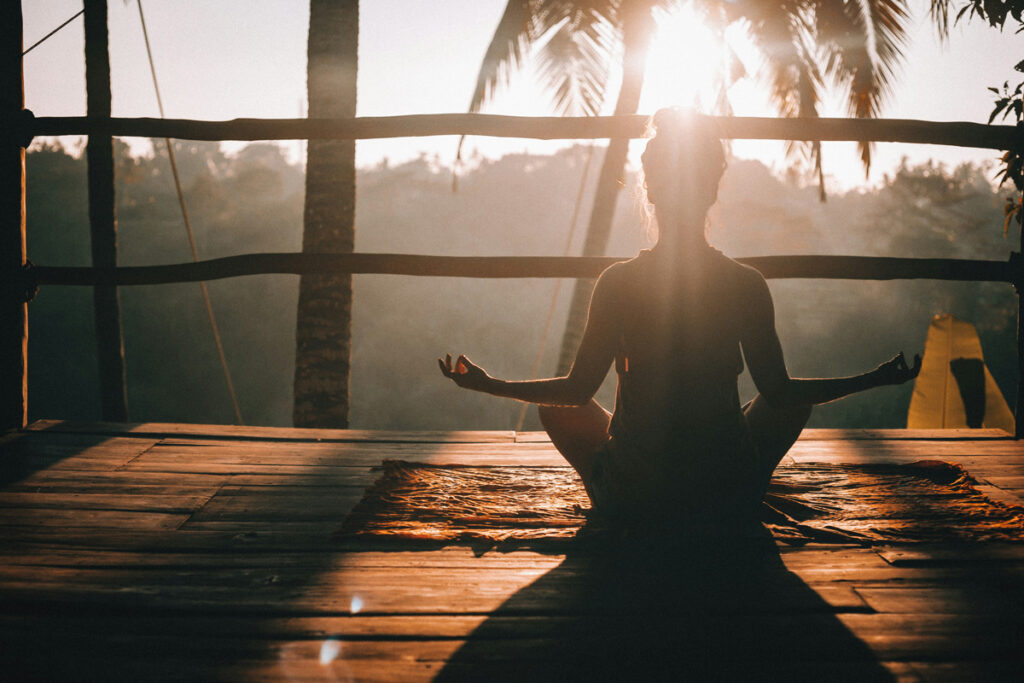
Whether you prefer a power vinyasa flow or a restorative yin, there are more yoga studios in Ubud than you could ever visit in one trip, with classes for every style and ability level.
Some of the more famous studios include Radiantly Alive and The Yoga Barn.
Personally, we are partial to Ubud Yoga House, which came recommended to us by a few different professional yoga instructors in Ubud for training. Situated along a serene rice paddy, on the edge of thick jungle, the morning vinyasa class is the perfect way to start your day.
Massage

Day spas abound in Ubud, where you can choose from a host of treatments that are all relatively cheap for those used to Western prices.
Some of the more highly rated spots include either Ubud Traditional Spa, Jaens Spa Center, or Karsa.
Or, for a cheaper hidden gem, we also found Synergy Spa, where a modest storefront belied a quality Balinese massage. Each treatment comes with aromatherapy oils of your choice, as well as a refreshing tea afterwards.
Sample Indonesian Coffee (Ethically)

If you’re the type that can’t sit still, you can still enjoy a more languid day by venturing to one of Ubud’s hip coffee shops to sample local brews. Indonesia is one of the top coffee exporters in the world, and knowledgeable baristas can help suggest a series of regional specialties to suit your taste.
Ubud Coffee Roastery is one of our favorites, specializing in 100% Indonesian Arabica beans. They offer single-origin brews from across Indonesia, thus allowing you to sample the subtle differences of five or six different sub-regions.
Seniman Coffee is another local legend for speciality brews, with a roastery just across the street from the shop.
And if you still aren’t caffeinated enough, make your way to Anomali Coffee. They take their mission to promote speciality Indonesian beans seriously, even offering a barista course through the Indonesian Coffee Academy.
Why not just visit a coffee plantation? A quick note on luwak coffee.

The novelty of luwak coffee has become quite a tourist draw in Bali.
The Asian palm civet, a jungle-residing mammal, has a strong nose for quality coffee. The animal will eat only the choicest beans, and farmers will then comb the civet’s excrement to salvage the whole beans and brew into a “superior” cup.
While it may be tempting to try this unusual coffee, the industry is infamous for its poor animal rights.
Captive civets are often treated horribly, and while some farms will advertise beans from “wild-only” civets, these claims are usually untrue. It’s extremely challenging to find a coffee plantation not serving the lucrative luwak brew.
Thus, building your own “coffee tour” of Ubud’s coffee houses is a great way to sample the regional specialties, while not supporting unethical farms.
Campuhan Ridge Walk
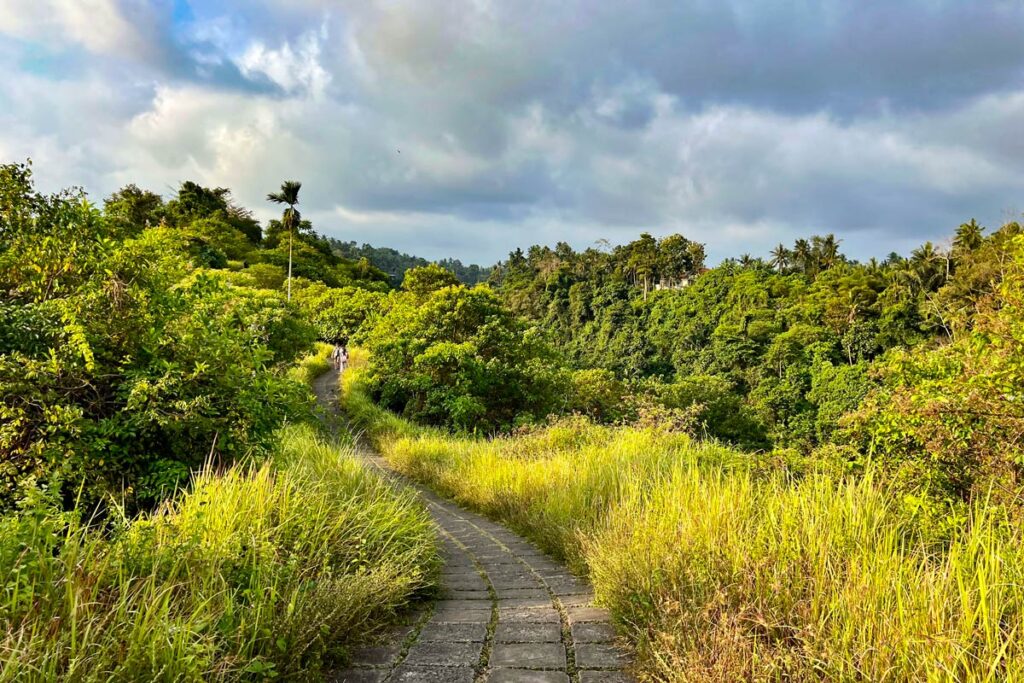
This famous pedestrian footpath traverses one of the primary hilltops running north out of town. At 4.5 kilometers (approximately 3 miles) roundtrip, you’ll gently wind over the ridge line with views of peaceful rice terraces and resorts tucked into the hillsides.
The walk is best either in the early morning or before sunset, when you can avoid the midday heat and the light is soft. Enjoy it today, either at first light or at the close of your relaxation day.
Day #4: Day Trip to Northern Bali
A day trip to northern Bali exposes you to a different side of the island, where tourist hordes are diminished. It’s a more authentic look at local village life, which we always find enlightening, and important to see and appreciate wherever we travel.
While northern Bali doesn’t appear far on a map, roads are slow and the drive takes about 2 hours each way from Ubud.
The easiest transportation is via private driver (see Private Cars section above). For around $40 USD for the day, your driver will pick you up and drive you wherever you want to go, before returning you to your hotel that evening.
Some of the more popular sites in northern Bali include Jatiluwih rice terrace, Ulun Danu Beratan temple, and Sekumpul waterfall.
Sangeh Monkey Forest
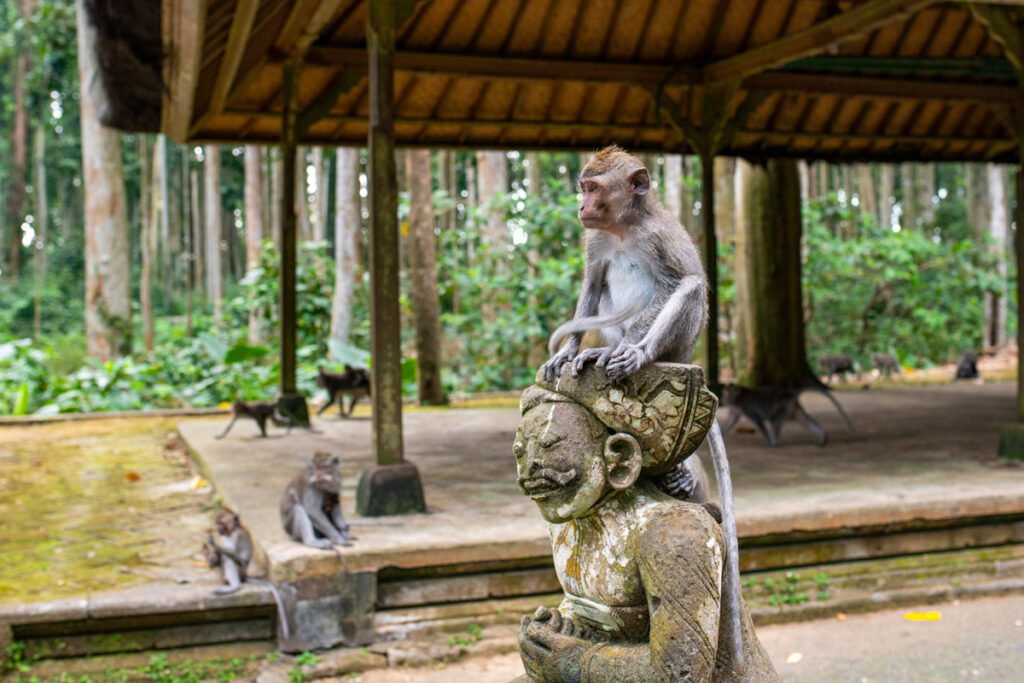
This hidden treat is on the way today, just 25 minutes outside of Ubud. Sangeh is similar to the Ubud Monkey Forest, but in a more natural surrounding with arguably less aggressive monkeys.
The protected forest consists of 14 hectares, as well as a 17th century temple. You’ll still see hundreds of macaques, who roam free on the grounds.
Local guides will lead you on a tour through the grounds, and help you capture plenty of photos with the monkeys. Just remember to tip your guide on your way out!
Safety Tip #1: be careful of your belongings. The macaques love snatching anything they can grab, and are smart enough to steal phones and sunglasses to barter for snacks. Don’t bring anything with you that you don’t absolutely need. Especially don’t carry food!
Safety Tip #2: don’t make eye contact with the monkeys. They see this as a sign of aggression, and will not hesitate to react. One member of our group momentarily forgot this cardinal rule and was immediately punched in the face.
Jatiluwih Rice Terraces
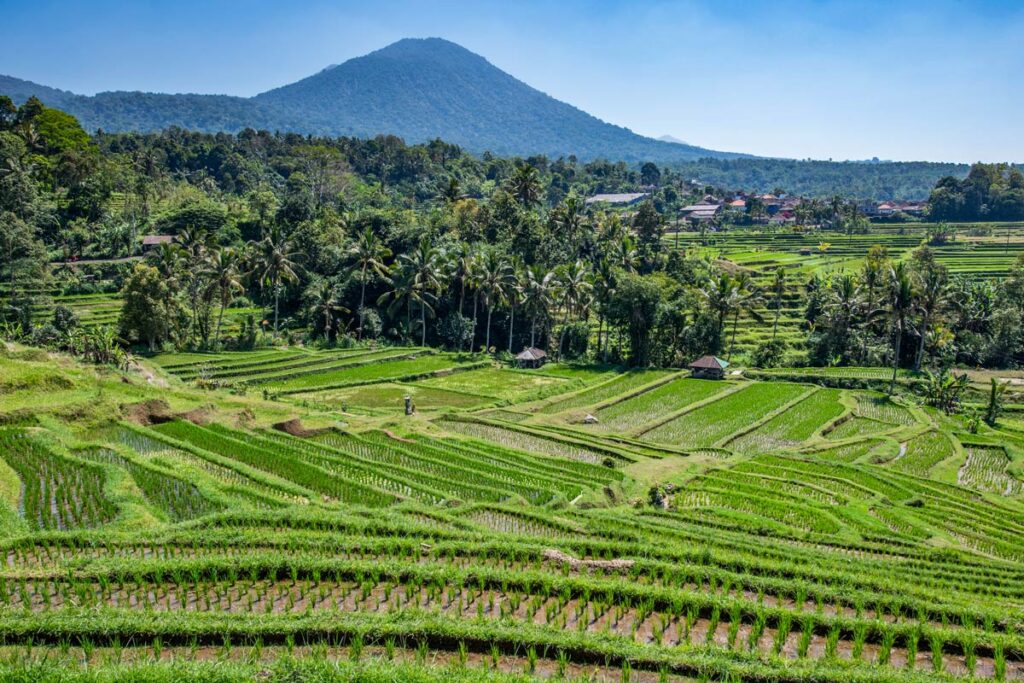
These emerald rice terraces sprawl over many hectares, and are positioned as a tourist alternative to Tegallalang (see above). Neither is better than the other, they’re just different.
Jatiluwih is much more expansive than Tegallalang, and you could easily spend an hour traversing the multiple kilometers of trails.
Jatiluwih is open farmland, and while it lacks the lush jungle of Tegallalang, the resulting vistas provide crisp views of Mount Abung, Bali’s tallest volcano.
Ulun Danu Beratan Temple
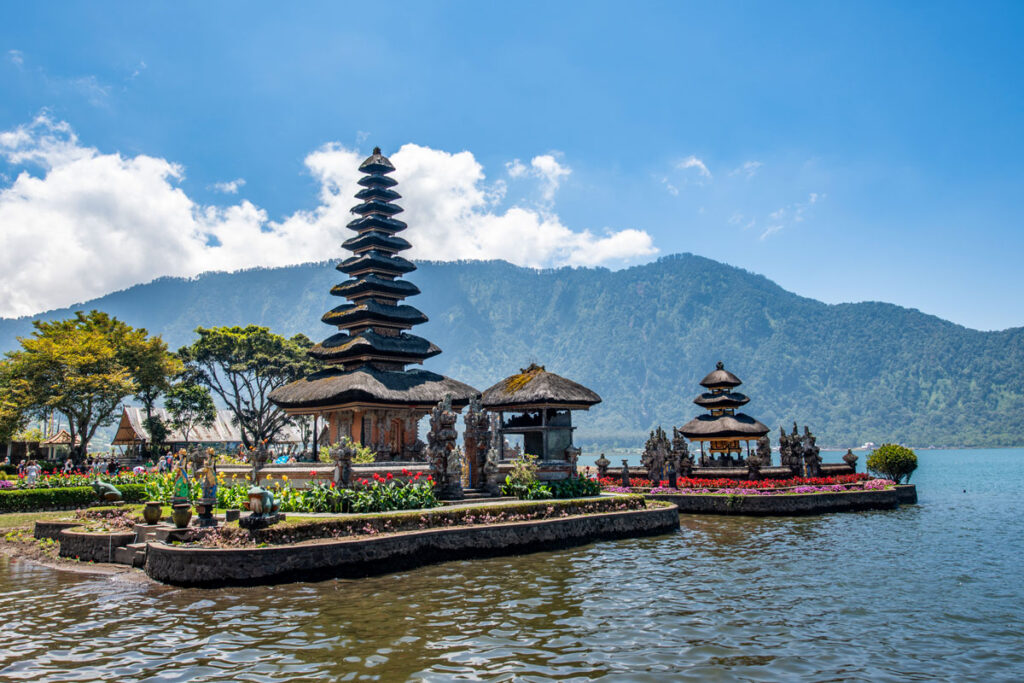
Ulun Danu is one of the most photographed spots on Bali. The 17th century Hindu temple, perched on a small island on Lake Beratan, is inaccessible to the visiting public. However, you can still admire it from the gardens along the shore.
It may be an unpopular opinion, but we found Ulun Danu to be underwhelming. You’ll pay an entrance fee to walk out to the edge of the lake, jostle tour coach crowds to get “the photo,” and…that’s it.
While we wouldn’t recommend driving out of your way from Ubud just to see Ulun Danu, if you happen to be in the area, you can swing by to grab the iconic picture.
Sekumpul Waterfall
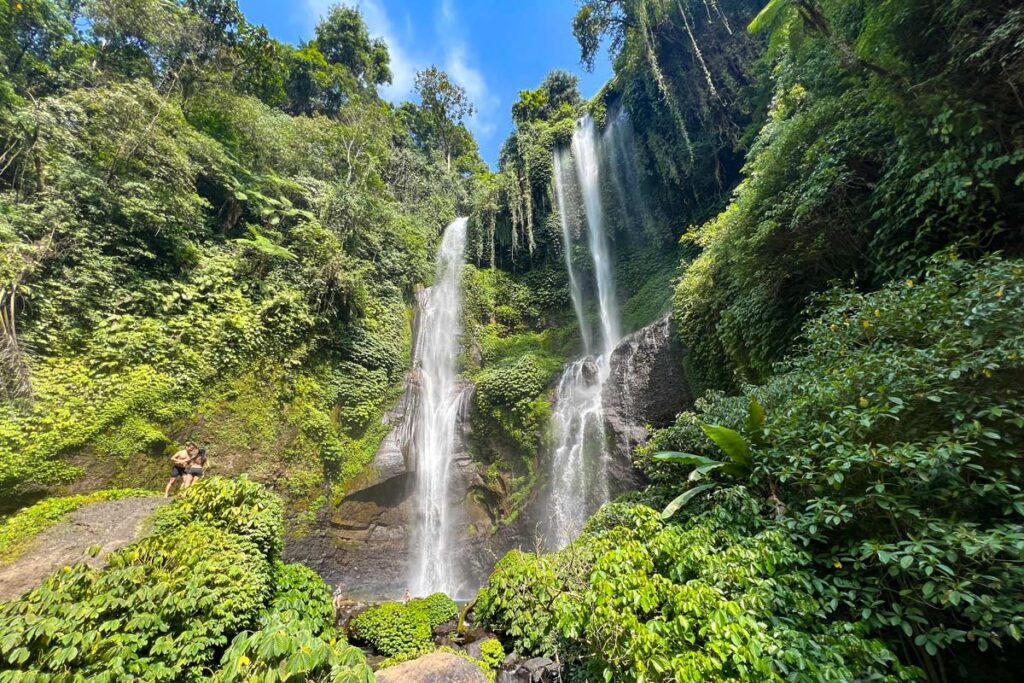
Sekumpul is the tallest waterfall on the island. It’s technically a few different streams, all of which flow down from a height of 80 meters (260 feet) to a small pool below.
You’ll also be able to visit Fiji Waterfall, another powerful cascade that’s just a 5-minute hike from Sekumpul and great for swimming.
At the parking lot, you’ll purchase your ticket (tickets are mandatory, to access the waterfalls) and be assigned a local guide. From here, it’s a 5-10 minute ride on the back of your guide’s motorbike to the trailhead.
The total hike is about 15 minutes each way, including a set of 350 stairs to the ravine below.
We recommend wearing comfortable sneakers or water shoes with grip, which help when traversing the dirt footpaths and scrambling over rocks to reach the falls. Just don’t forget a bathing suit!
